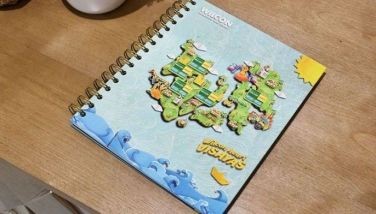Dental Care for Kids
CEBU, Philippines – As soon as the child's mouth is full of teeth, food particles easily get stuck in between. If this is not addressed, the teeth could develop cavities. Of course, parents don't want
this to happen.
This month of February, as the nation celebrates the 11th National Dental Health Month, themed "Nakangiti ang Kinabukasan, Kapag Ngipin ay Pinangangalagaan," it is only fitting to devote time in learning how to take care of teeth, especially those of kids.
By age three, most children will already have 20 baby teeth. Sadly, even before they could have all 20, some children already develop tooth decay called "early childhood caries" (ECC), also known as "baby bottle caries." This is a common bacterial infection involving the top front teeth and the first molar teeth.
According to Dr. Pamela Fernandez of Dental Innovations, ECC is the presence of one or more decayed teeth (due to carries), or filled tooth surfaces in the primary tooth of kids under the age of six. Simple sugars in the food they eat contribute to the build-up of bacteria in the kids' mouth.
During early decay, Dr. Fernandez added, white spots start to form around each teeth, particularly the front ones, due to milk consumption. In a moderate decay, brown spots, which are soft to the touch, start to be evident. However, in the advance stage, the teeth already turn black.
"ECC tends to affect the upper teeth because they come out earliest or less protected by saliva. It is important that we take care of the baby teeth because if infected, there's a possibility that it can affect the developing permanent teeth," Dr. Fernandez emphasized.
Strong teeth help the child chew the food necessary for him to grow. The quality of a child's teeth can also affect his speech. Not to mention that having a good set of teeth makes one look good and feel more confident. That is why parents should help make their children understand the importance of healthy teeth.
Children should be taught about plaque, a clear form of bacteria that sticks to the teeth that are not properly brushed. Children should know that after eating sweets or a piece of cake, or drink soda and other sugary food and drinks, bacteria develops in the mouth and start digging into the teeth for more of the sweet treat. The bacteria would break down the tooth enamel with acids, causing holes called cavities.
Parents should explain to the children that proper brushing of the teeth prevents the formation of plaques and that failure to take care of the teeth would later on cause them pain, oral infection, difficulty in chewing (which may lead to poor nutrition), loss of sleep and concentration, and difficulty in speaking, among others.
Children shall be made to understand that good eating habits keep their teeth healthy and they need to be careful of what they eat and drink. Too much sweet and sticky food should be avoided, and have dairy foods for these can help prevent decay because of their protein content. It is healthier to eat lots of fruits and vegetables and drinking plain water instead of drinking soda that might stain or discolor the teeth.
The kids must realize that without dental care, it will be difficult for them to eat their meals, and that their sweet smile would suffer if they have cavities.
With parents' supervision and assistance, toddlers can be encouraged to take good care of their teeth as early as now. The Ramon Aboitiz Foundation Inc.-Dolores Aboitiz Children's Fund, a big advocate of Early Child Care and Development, recommends the following ideas when brushing the child's teeth.
1. Choose a soft-bristled toothbrush especially designed for children aged two to five years old. These toothbrushes have small oval heads and a non-slip cushioned handle. Fun cartoon designs on the handle, which are appealing to children, are available.
2. Choose low-fluoride toothpaste. Fluoride is a mineral that strengthens tooth enamel and reduces tooth decay. There are plenty of toothpaste choices - variety of colors and flavors to choose from, and some made just for kids. Just a pea-sized amount of toothpaste on the brush will do for starters.
3. Let the child take his time when brushing. The bristles of the toothbrush shall be angled towards the gum. The brush must move in gentle circles to clean the outer and inner sides of the teeth and gums.
4. Assist the child to do an up-and-down motion of the brush, to dislodge most food particles on the chewing surfaces of the teeth. The child's tongue, too, shall be brushed gently. Let the child spit the toothpaste out as you clean.
5. Each brushing shall at least take two to three minutes. You can actually play a three-minute children song for some fun and to time the brushing.
6. Modify the child's eating habits. Have them refrain from eating chocolates and drinking colored drinks. As much as possible, encourage them to eat more fruits and vegetables during meals and snack time.
7. For infants, after they drink their milk, give them a glass of water to cleanse the sugar in their mouth.
Train them to drink as much water as possible.
8. Establish dental health care practices at home.
Also, parents must train the kids to take charge of their daily dental routine. They can brush their teeth before a mirror so they can see their mouth. Brushing shall be done at least twice a day - after breakfast and before bedtime.
Children should also be taught of the importance to visit the dentist twice a year. The dentist could teach the children the best way to brush and floss. He can also check for early signs of cavities or gum problems.
(Sources: http://kidshealth.org; http://raisingchildren.ne)
- Latest































